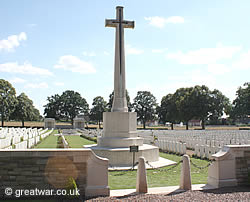The South Africa (Delville Wood) National Memorial, Longueval
The memorial at Delville Wood is a national memorial dedicated to all South Africans who served in all theatres of war.
It is the only memorial dedicated to the participation of the South African Forces on the 1914-1918 Western Front. 229,000 officers and men served with the South African Forces in the Great War. Their casualties who died in action or who died of wounds numbered approximately 10,000. All those who died in the service of the Union of South Africa are named in a book held at the Delville Wood Museum next to the memorial. This memorial does not bear the inscribed names of South Africans missing in action on the Western Front. The names of the missing South Africans are included on memorials to the missing of the United Kingdom.
- Design
- Unveiling Ceremony
- Second World War Memorial: the Altar Stone
- The Wood as a Memorial
- The “Last Tree”
- The Davies-Hill Memorial
- Visitor Information
- Location
- Museum to the South African Forces
Design
Location in Delville Wood
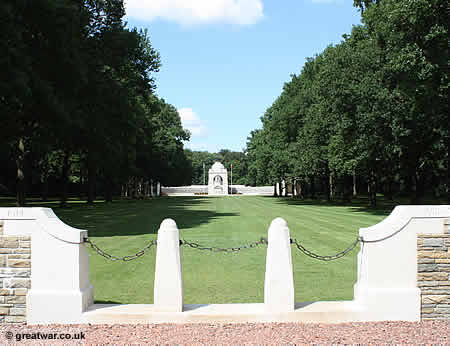
|
The memorial is located at the end of a central avenue leading into Delville Wood from the main entrance.
This place is where the battalions of the South African Brigade came under withering German artillery fire in their attempt to capture and then defend the wood in mid July 1916. This attack was against the German Second Position and the South African Brigade was serving with the British 9th Division in this action. Both the wood and the South African battalions were almost completely destroyed. The South African Brigade had gone into battle here on 15th July 1915 with a strength of 121 officers and 3,032 other ranks. At roll call on 21st July they numbered only 29 officers and 751 other ranks.(1)
The Official History of the Great War 1914-1918 records the courage of the South Africans holding the wood:
“The South Africans had covered themselves with glory at Delville Wood, which is now laid out as a memorial to their dead. In spite of terrible losses, they had steadfastly endured the ordeal of the German bombardment, which seldom slackened and never ceased, and had faced with great courage and resolution repeated counter-attacks delivered by fresh [German] troops. Since their first advance into the wood on the morning of 15th July they had defied all attempts to drive them completely from it.” (2)
Memorial Arch
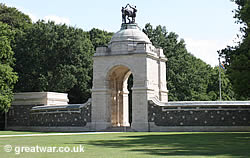
|
The memorial building, designed by Sir Herbert Baker, has an arch in the centre, with a flint and stone semi-circular screen leading off to the right and left of the arch, with a shelter building at each end of the screen.
The arch bears an inscription in English and Afrikaans:
“Their ideal is our legacy
Their Sacrifice our inspiration”
Bronze Sculpture
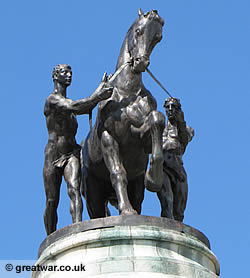
|
A bronze sculpture by Alfred Turner of a horse and two male figurs is located on top of the arch. The two men represent the two white races of the South African Union, British and Afrikaans.
The figures were intended to symbolise the Greek and Roman mythological figures of Castor and Pollux, the twins who had one mother and two different fathers, one mortal and one immortal, making Castor mortal and Pollux immortal.
Unveiling Ceremony
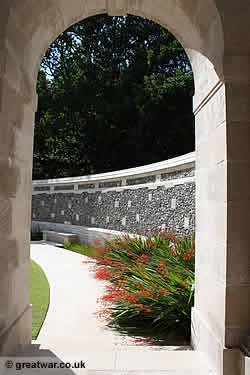
|
The South African Memorial was unveiled at a ceremony on 10 October 1926. Attending the ceremony were the widow of General Louis Botha, Prime Minister General J M B Hertzog, Sir Percy Fitzpatrick and Field-Marshal Sir Douglas Haig.
Second World War Memorial: the Altar Stone
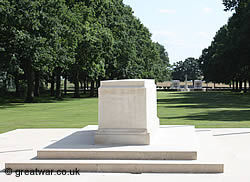
|
An altar stone is located at the centre point between the two shelter buildings in line with the arch. This is dedicated to the losses of South African Forces in the Second World War.
The Altar Stone was unveiled on 5 June 1952 by Mrs Olive Swales, the mother of the late Major Edwin Essery Swales, VC, DFC who had served with the South African Air Force in the Second World War. Major Swales was posthumously awarded the Victoria Cross for his gallant action on a Royal Air Force “Pathfinder” raid on Pforzheim on 23rd February 1945. In spite of damage inflicted on his Lancaster from enemy fighters he carried out his duties as Master Bomber calmly and then turned for home. The situation became untenable during the next hour as the plane began to lose height. Swales ordered all of his crew to parachute to safety while he held the aircraft steady. Just after the last man had left the aircraft the Lancaster bomber crashed to earth near Valenciennes with Major Swales at the controls. Major Swales, VC, DFC, is buried at the Leopoldsburg War Cemetery (Plot VIII, row C, grave 5), Leopoldsburg, Limburg, Belgium.
The inscription on the altar stone at Delville Wood reads:
“This altar stone has been erected by the government of the Union of South Africa to commemorate the sacrifices of all South Africans who gave their lives in all theatres of war on land on the sea in the air in the World War of 1939-1945, Unveiled 5th June 1952”
The Wood as a Memorial
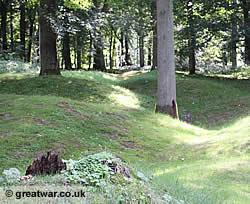
|
After the war the wood was purchased from the French owner of the land in 1920 by the South African Government, with the involvement of the South African politician and author Sir Percy FitzPatrick. It was Sir Percy who suggested in a letter to King George V on 27 October 1919 that a moment of silence should be observed on the forthcoming first anniversary of the Armistice of 11.00 hours on 11 November 1919.
This place, the site of the first major action on the Western Front by the South African Brigade, was considered a fitting place to commemorate all South African soldiers who fought and died during the First World War. The grounds of the wood were not cleared and for many hundreds of soldiers this wood remains their final resting place. The names of the British and South African men missing in action and with no known grave here are recorded on British & Commonwealth Memorials to the Missing, such as the Thiepval Memorial to the Missing (see our Related Link below).
The ground was left more or less as it was at the end of the war and was replanted with young trees by the South African Department of Forestry. The original rides or paths through the wood of 1914-1918 were preserved as wide, grassed rides.
The Central Avenue
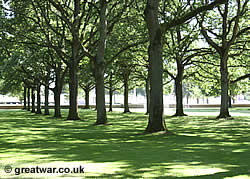
|
The Central Avenue leads from the main entrance at the Longueval-Ginchy road into the wood to the memorial and museum. Two rows of oak trees were planted on either side of this impressive avenue. The oak trees were planted from acorns growing on a tree in South Africa in the 1920s, which had been planted there in 1688 by a French Hugenot settler called Monsieur Jean Gardiol.
The Rides
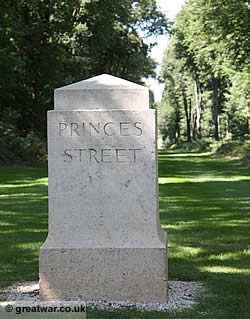
|
Typical of the common practice of using familiar names to identify battlefield locations on British Army maps, the rides existing in Delville Wood at the time of the 1916 Battle of the Somme were given names of streets known to the soldiers:
- Rotton Row
- Regent Street
- Bond Street
- Buchanan Street
- Campbell Street
- Princes Street
- King Street
- Strand Street
In spite of its rather unpleasant sounding name, Rotten Row was a length of track running along the south edge of Hyde Park to Hyde Park Corner in London. At the time of the 1914-1918 war it was a fashionable place for upper-class Londoners to meet and be seen.
Stone markers have been placed at the intersections of these rides with their British Army names.
The “Last Tree”
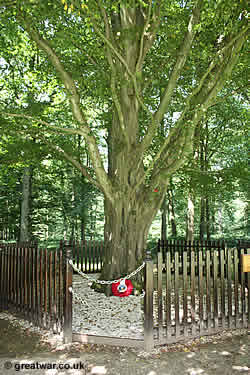
|
The “Last Tree” is the only surviving hornbeam tree in Delville Wood, or Devils Wood as it was also known to the British Army. During the battle to capture the wood from the German Army from 15 July 1916 the German artillery shelled the British-held position to a pulp. The artillery shells splintered and smashed virtually every tree until the wood was almost completely destroyed.
This single hornbeam tree is the only tree that survived the shelling more or less intact and i has continued to grow since the war. Visitors will see that trunk is studded with shards of metal artillery shell casing.
The tree is looked after by the Commonwealth War Graves Commission. The South African Air Forces Association placed a fence around the tree in 2009.
Location of the Last Tree
The “Last Tree” is located in the centre of the wood just to the west side of the South African Forces Museum building.
The Davies-Hill Memorial
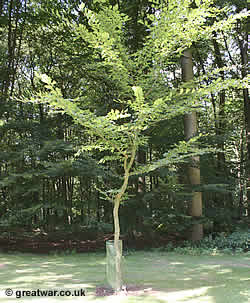
|
A tree was planted in the wood in memory of two British soldiers who were awarded the Victoria Cross for their gallantry in action during the battle at Delville Wood on 20 July 1916.
Corporal (later Staff Sergeant) Joseph John Davies, VC and Private Albert Hill, VC were serving with the 10th (Service) Battalion the Royal Welsh Fusiliers. Both soldiers survived the war.
The citations for these Victoria Cross winners were announced in the London Gazette on 26 September 1916 as follows:(3)
“No. 34314 Cpl. Joseph Davies, R. Welsh Fus.
For most conspicuous bravery. Prior to an attack on the enemy in a wood he became separated with eight men from the rest of his company. When the enemy delivered their second counter attack his party was completely surrounded, but he got them into a shell hole, and, by throwing bombs and opening rapid fire, succeeded in routing them. Not content with this he followed them up in their retreat and bayonetted several of them.
Corporal Davies set a magnificent example of pluck and determination. He has done other very gallant work, and was badly wounded in the second battle of Ypres.”
“No. 15280 Pte. Albert Hill, R. Welsh Fus.
For most conspicuous bravery. When his battalion had deployed under very heavy fire for an attack on the enemy in a wood, he dashed forward, when the order to charge was given, and, meeting two of the enemy suddenly, bayonetted them both. He was sent later by his platoon Serjeant to get into touch with the company, and, finding himself cut off and almost surrounded by some twenty of the enemy, attacked them with bombs, killing and wounding many and scattering the remainder.
He then joined a serjeant of his company and helped him to fight the way back to the lines.
When he got back, hearing that his Company Officer and a scout were lying out wounded, he went out and assisted to bring in the wounded officer, two other men bringing in the scout.
Finally, he himself captured and brought in as prisoners two of the enemy. His conduct throughout was magnificent.”
Visitor Information
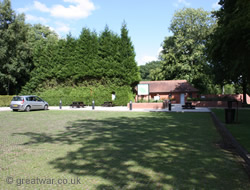
|
Visitors are advised that the Information Centre and toilets at the car park for the museum and memorial were closed in 2010 and have not been open on a permanent basis since. If the toilets are open and available to visitors, please be advised also that the normal closure opening hours are daily 10.00 to 18.00 hours, closed on Mondays.
Parking
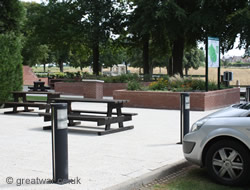
|
Visitors are required to park and walk to the memorial and museum in Delville Wood. There is a large, free designated car park within a few minutes' walk of the memorial and museum.
The car park is open:
- Summer 10.00 - 17.30 hours
- Winter 10.00 - 16.00 hours
Location
The memorial museum is located in the southern part of Delville Wood (Bois Delville). The wood is on the east side of Longueval village and is signposted from the centre of Longueval village.
Related Topics
Museum to the South African Forces
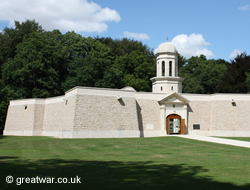
|
In 1984 a museum to the South African Forces was built in Delville Wood next to the Delville Wood Memorial. Find out more about the museum at our page:
Museum to the South African Forces, Delville Wood
Delville Wood Cemetery, Longueval
The third largest British & Commonwealth cemetery on the Somme battlefields is located close to the South Africa (Delville Wood) National Memorial and Museum. There are 160 South African burials in the cemetery, 95 of whom are identified.
Acknowledgements
(1) Military Operations: France and Belgium, 1916, Volume II p. 108
(2) Military Operations: France and Belgium, 1916, Volume II p. 108
(3) London Gazette, dated 26 September 1916, page 9418.
Delville Wood Commemorative Museum Trust:
Website: www.delvillewood.com
Commonwealth War Graves Commission (CWGC). To find out more about the Commission and the work it does, free educational resources or to search for the burial or commemoration place of a serviceman or woman visit the website:
Website: www.cwgc.org

